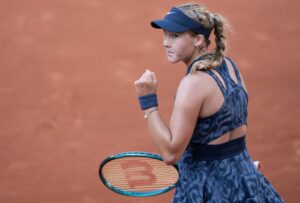There were many reasons to love the Davis Cup semi-finals last weekend: the closeness of the competition, as both semi-finals went to the final day (and in the case of Belgium–Australia to the final rubber); the frenzied but still friendly support provided by the supporters of all four nations, particularly the few dozen Aussie “Fanatics” who tried to cheer their team to victory in Brussels; and the sheer sportsmanship on view, not only among the players but among the captains and coaching staff, too. However, for me personally, the undoubted highlight of both semi-finals was the action on the middle day, when, for an all-too-brief period, the Davis Cup provided a reminder of the greatness of doubles tennis.
The late, great, tennis-loving Robin Williams famously said, “Tennis is chess played at 90 miles per hour”. Well, according to that logic, doubles is chess played at 180 miles per hour. The speed of the shots on display in both the Davis Cup semi-finals must have got somewhere near that mark, as did the reaction times of the players themselves. For example, Australia’s John Peers, who paired up with Jordan Thompson in the doubles, repeatedly demonstrated cat-like reflexes as he covered seemingly the whole net by himself, cutting off numerous attempted returns by the Belgian pairing. It is no wonder that he is currently ranked No.2 in the world in doubles (behind only Henri Kontinen of Finland) and won last year’s Australian Open doubles title with Britain’s Jamie Murray.
Embed from Getty Images
However, the sad truth is that last weekend’s spectacular doubles play in the Davis Cup was also a rather poignant reminder of the reduced status of doubles play in the 21st century. It is only in the Davis Cup that doubles retains the central status that it once had in the whole of tennis and even in the Davis Cup itself it is under threat.
Davis Cup Provides a Reminder of the Greatness of Doubles
The International Tennis Federation has long tried to restore the importance of the Davis Cup among the main men’s singles players, notably suggesting that Davis Cup ties should take place over two days rather than three. Thankfully, these plans are at least on hold for the time being and, frankly, they should be binned permanently, because far from enhancing or restoring the status of the Davis Cup they would inevitably damage it, by restricting the number of nations that have a realistic chance of winning the trophy. Currently, a tennis nation really only needs two outstanding players to compete for the greatest prize in international team tennis, as was brilliantly proved by the Murray brothers in 2015, when they teamed up in doubles to help Britain win the Davis Cup for the first time in 77 years. Like other great players before him, notably Ivan Ljubicic of Croatia in 2005, Andy Murray was able to play two singles rubbers and in the doubles on the middle Saturday. If Davis Cup ties were reduced to two-day events, it would be impossible for Murray, Ljubicic or any other player, however good they were, to play both singles and doubles in the Davis Cup, and that, surely, would mark the death-knell for doubles as a serious, integral part of tennis.
Embed from Getty Images
The reduced importance of doubles is a relatively new phenomenon. Throughout most of the history of the game, the best players – both male and female – played both singles and doubles, with Margaret Court, for example, winning a staggering 19 women’s doubles Grand Slam titles and an almost unbelievable 21 mixed doubles Grand Slam titles to go alongside her 24 Major singles titles. And lest anyone think that it was only female players who could combine singles and doubles play, it is worth pointing out that Rod Laver, for instance, won six Grand Slam men’s doubles titles and a further three Grand Slam mixed doubles titles in addition to his 11 Major singles titles. Put simply, for much of tennis history the top players of both genders regarded doubles play not as a hindrance to their singles play but as a wondrous addition to it, almost substituting it for practice (and thus proving the adage that most professional sportspeople would rather play than train). And at a time when most great tennis players were serve-volleyers, as was the case until the introduction of non-wooden rackets from the 1980s onwards, playing doubles provided the best possible practice for volleying.
Borg v McEnroe – A singles, not doubles rivalry
It was really with the arrival of Bjorn Borg in the early 1970s that doubles began to lose its sheen. Borg did play men’s doubles at the Grand Slams early in his career, but as his singles career sky-rocketed he eventually stopped playing doubles completely and, significantly, never even reached a Grand Slam doubles final, let alone won one.
Embed from Getty Images
The pattern established by Borg has continued and intensified ever since, especially for the top male tennis players. Indeed, the last great male champion to play doubles on a regular basis was Borg’s arch rival, John McEnroe, who, playing mainly with his fellow countryman Peter Fleming, actually ended his astonishing and controversial career with more doubles titles at the Slams than singles titles. (He won nine men’s doubles Majors to seven singles Majors and interestingly, as in the singles, all of his doubles titles came at either Wimbledon or the US Open.) However, as in so many ways McEnroe was very much the exception to the rule, the rule being that as tennis became fully professional and the fitness demands on the top players correspondingly increased exponentially, fewer and fewer top players, especially among the men, continued to play doubles.
Combined with a general decline in the serve-volleying style, it has meant that few tennis players are now truly comfortable at the net. That was shown again last weekend, notably in Belgium, when, for all their other herculean efforts on behalf of their country, David Goffin and Steve Darcis routinely dumped volleys into the net, which, in any other era before this one, top players of their calibre would have made.
Embed from Getty Images
Will doubles ever return to its former glory?
Perhaps the decline of doubles is irreversible – but perhaps not. In addition to preserving its status in the Davis Cup (and, thankfully, that status now seems to be secure at least for the time being), greater efforts should be made to enhance its status at the Majors. (Enhancing its status is probably the only realistic ambition at the moment, as it now seems impossible to restore doubles to its former glory.) One simple way of doing so would be to have a dedicated “Doubles Day” for the finals of the men’s doubles, the women’s doubles and the mixed doubles. Although the scheduling at the end of Slams is notoriously tight, it is not beyond the wit of schedulers to, say, make the final Saturday, after the completion of the women’s singles final, a dedicated “Doubles Day”, or even half-day. Most importantly, far greater efforts must be made to ensure that doubles finals are played in front of a full house, as there is nothing more dispiriting for doubles enthusiasts than seeing doubles finals played out in half-empty or even completely empty stadia. If arranging a dedicated “Doubles Day” is ultimately impossible, it is absolutely not impossible to ensure that anyone who leaves centre court after a singles final is replaced by somebody else (even a child) who desperately wants to see a doubles final and does not regard it as an irrelevance or an afterthought.
Doubles play will almost certainly never regain its former grandeur, when the greatest male and female singles players, like Court and Laver, also competed in the two-person format of the game. Nevertheless, it is absolutely vital to ensure that doubles play remains a key component of the Davis Cup, and infinitely greater efforts need to be made by the Majors to ensure that Major doubles finals are played out in front of full houses rather than empty grandstands.
Main Photo:
Embed from Getty Images






